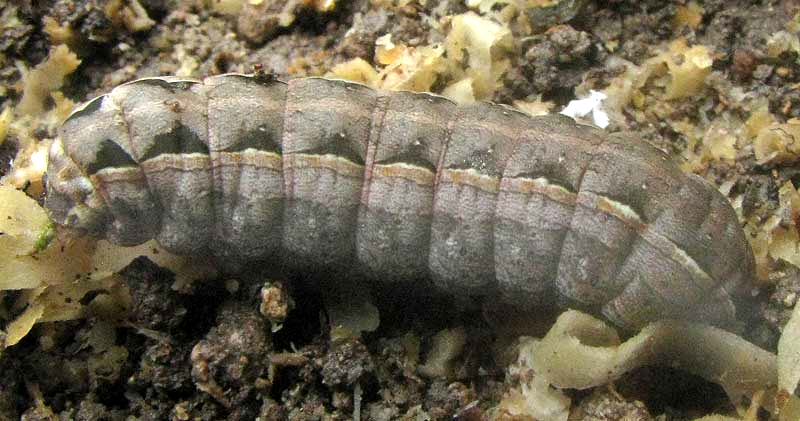Excerpts from Jim Conrad's
Naturalist Newsletter

from the October 20, 2013 Newsletter issued from the Frio Canyon Nature Education Center in the valley of the Dry Frio River in northern Uvalde County, southwestern Texas, on the southern border of the Edwards Plateau; elevation ~1750m (~5750 ft); N29.62°, W99.86°; USA
VELVET ARMYWORM
While watering the raised beds of mustard and turnip greens I saw an especially plump, 1¾-inch-long (45mm) caterpillar inching among the plants. Being so large, I thought he might be looking for a place to pupate. That's him above.
Volunteer identifier Bea in Ontario had problems figuring out who this one was, partly because so many pictures on the Internet are misidentified. Bea sent the image to experts at the Butterflies and Moths of North America website and even they took longer than usual to figure out that we had what's variously called a Velvet, Garden, or Lateral-lined Armyworm, SPODOPTERA LATIFASCIA. Bea and I had just about decided that it was Spodoptera ornithogalli, a common across most of North America. However, the BOMONA expert determined that "The line along the side just doesn't look strong and sharp enough..." to be that species. Now our picture resides at https://www.butterfliesandmoths.org/sighting_details/937273.
Velvet Armyworms are a hot-weather-loving species, in the US turning up mainly along the Gulf Coast from Texas to Florida, and south through the Americas to Argentina in South America. The caterpillars metamorphose into moths with tan and brown wings held back over their bodies. The wings are fairly unspectacular unless you look closely at the fine details.
Velvet Armyworm caterpillars are "general feeders" capable of damaging gardens, where they've been seen eating asparagus, bean, corn, cowpea, pepper, potato, sweet potato, turnip and more. In Florida they eat ornamental plants. Mainly they eat leaves, but they can function as cutworms when they remove entire plants, cutting the stem at the soil surface. Soon after hatching, the caterpillars cluster in groups, and often are parasitized by various insects who lay eggs inside their bodies, which kills them. As surviving caterpillars grow they wander off and begin eating alone.